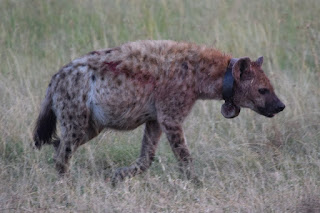Much like kids on the playground, when a spotted hyena male
has a crush on a female he begins a complicated set of behaviors similar to
flirting. Female spotted hyenas are larger, more aggressive, and socially
dominant to males, so interested males must carefully follow a set of courting
behaviors in order to gain favor with and avoid a good bite from females. These behaviors are sometimes antagonistic, sometimes
submissive, and sometimes downright bizarre.
Courtship behavior often starts as it does in humans. A male
will pick out a lady he finds particularly attractive and attempt to get close
to her, even following her around in the hopes she’ll take a liking to him.
 |
Watch our Sauer! He's right behind you!
|
One of the most common courting behaviors we see is called
an “approach avoid”. This behavior looks exactly as it sounds- males will
rapidly approach a female and then rapidly retreat. Because males are so
nervous around these large-and-in-charge ladies, they will run away even if the
females completely ignore them. If a male approaches a female several times
from a distance (sometimes as far as 10m) and she does not attack him, he’ll
get closer and closer to test the waters until she’s fed up and lunges him
away. He’ll keep up this behavior, even after being attacked by a female, if
he’s particularly infatuated. This is a way for males to assess how aggressive
a female is feeling, and how receptive she is to his proximity.
 |
| Toledo realizing he's made a mistake as Whiz lunges toward him. |
Once a male has approach-avoided his way up close to his
female of choice, he will then perform some smaller, equally as frantic,
behaviors to attract her attention. One of these behaviors is pawing ground and
looks like a dog digging in the dirt. Males have interdigital (between
toe) scent glands, and pawing the ground in the direction of a female serves to
deposit his scent for the female to smell, much like a young boy making mud
pies to gain the favor of his kindergarten crush. Next up is foreleg grooming. To ensure that his hair is looking nice and smooth, a male will begin licking his front legs in the direction of a female.
 |
| Leprechaun licks his foreleg. |
Finally, if all has gone well and his selected lady seems
receptive to this male’s particular style of flirting, he will perform the
ultimate courting act- the bow. A male will approach his female, lift one
foreleg, and cross it over the other. He then bows his head in the ultimate act
of submission. We are incredibly lucky to have witnessed this behavior as it is one of the most bizarre and magical
behaviors that hyenas perform.
Tune in to Kate's next post which will explore what happens when all of these behaviors are performed to perfection, and the female chooses her mate.
References
Szykman, M., Horn, R. C. Van, Engh, A. L., Boydston, E. E., & Holekamp, K. E. (2007). Courtship and mating in free-living spotted hyenas. Behaviour, 815-846.



























